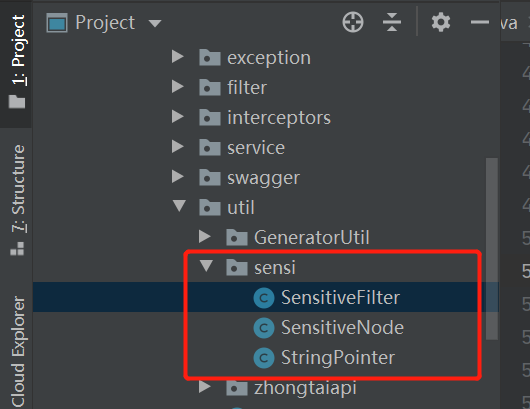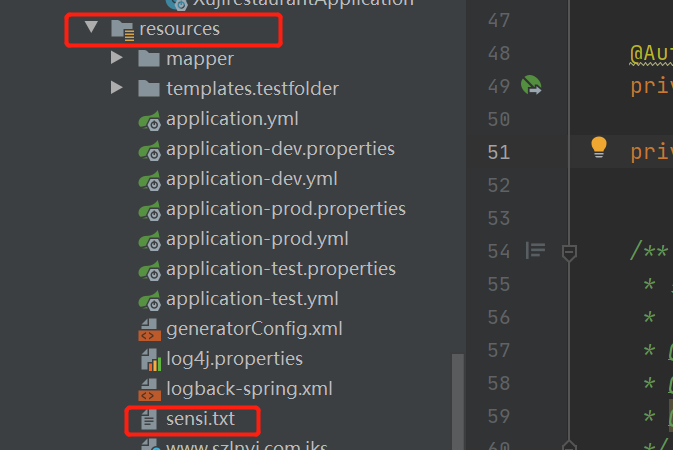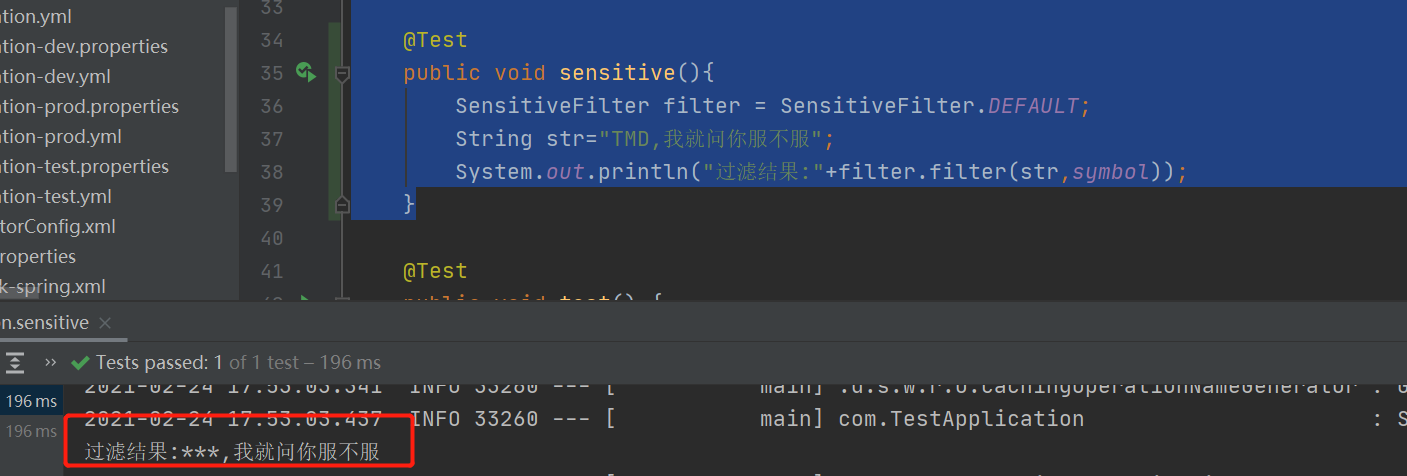springboot项目怎么过滤敏感词
前言:
我们通常在做聊天、留言模块功能的时候,会遇到一个问题,铭感词的处理。那么该怎么处理,到达文明聊天目的。
设计思路:
建立自己的敏感词典,对聊天记录进行过滤,将一些敏感词或者敏感的语言替换成"*"。
项目结构:
SensitiveFilter、SensitiveNode、StringPointer类的位置

示例:
1、首先建立自己的敏感词典,在resources下面创建一个sensi.txt文件。sensi.txt文件用来存放敏感词
注意:每行一个敏感词
sensi.txt 文件的位置

2、业务逻辑
SensitiveFilter 类
package com.fb.xujirestaurant.util.sensi;
import org.springframework.core.io.ClassPathResource;
import org.springframework.core.io.Resource;
import java.io.*;
import java.nio.charset.StandardCharsets;
import java.util.NavigableSet;
/**
* 敏感词过滤器,以过滤速度优化为主。<br/>
* * 增加一个敏感词:{@link #put(String)} <br/>
* * 过滤一个句子:{@link #filter(String, char)} <br/>
* * 获取默认的单例:{@link #DEFAULT}
*
* @author ZhangXiaoye
* @date 2017年1月5日 下午4:18:38
*/
public class SensitiveFilter implements Serializable {
private static final long serialVersionUID = 1L;
/**
* 默认的单例,使用自带的敏感词库
*/
public static final SensitiveFilter DEFAULT = new SensitiveFilter(
new BufferedReader(new InputStreamReader(SensitiveFilter.class.getClassLoader().getResourceAsStream("sensi.txt")
, StandardCharsets.UTF_8)));
/**
* 为2的n次方,考虑到敏感词大概在10k左右,
* 这个数量应为词数的数倍,使得桶很稀疏
* 提高不命中时hash指向null的概率,
* 加快访问速度。
*/
static final int DEFAULT_INITIAL_CAPACITY = 131072;
/**
* 类似HashMap的桶,比较稀疏。
* 使用2个字符的hash定位。
*/
protected SensitiveNode[] nodes = new SensitiveNode[DEFAULT_INITIAL_CAPACITY];
/**
* 构建一个空的filter
*
* @author ZhangXiaoye
* @date 2017年1月5日 下午4:18:07
*/
public SensitiveFilter() {
}
/**
* 加载一个文件中的词典,并构建filter<br/>
* 文件中,每行一个敏感词条<br/>
* <b>注意:</b>读取完成后会调用{@link BufferedReader#close()}方法。<br/>
* <b>注意:</b>读取中的{@link IOException}不会抛出
*
* @param reader
* @author ZhangXiaoye
* @date 2017年1月5日 下午4:21:06
*/
public SensitiveFilter(BufferedReader reader) {
try {
for (String line = reader.readLine(); line != null; line = reader.readLine()) {
put(line);
}
reader.close();
} catch (IOException e) {
e.printStackTrace();
}
}
/**
* 增加一个敏感词,如果词的长度(trim后)小于2,则丢弃<br/>
* 此方法(构建)并不是主要的性能优化点。
*
* @param word
* @author ZhangXiaoye
* @date 2017年1月5日 下午2:35:21
*/
public boolean put(String word) {
// 长度小于2的不加入
if (word == null || word.trim().length() < 2) {
return false;
}
// 两个字符的不考虑
if (word.length() == 2 && word.matches("\\w\\w")) {
return false;
}
StringPointer sp = new StringPointer(word.trim());
// 计算头两个字符的hash
int hash = sp.nextTwoCharHash(0);
// 计算头两个字符的mix表示(mix相同,两个字符相同)
int mix = sp.nextTwoCharMix(0);
// 转为在hash桶中的位置
int index = hash & (nodes.length - 1);
// 从桶里拿第一个节点
SensitiveNode node = nodes[index];
if (node == null) {
// 如果没有节点,则放进去一个
node = new SensitiveNode(mix);
// 并添加词
node.words.add(sp);
// 放入桶里
nodes[index] = node;
} else {
// 如果已经有节点(1个或多个),找到正确的节点
for (; node != null; node = node.next) {
// 匹配节点
if (node.headTwoCharMix == mix) {
node.words.add(sp);
return true;
}
// 如果匹配到最后仍然不成功,则追加一个节点
if (node.next == null) {
new SensitiveNode(mix, node).words.add(sp);
return true;
}
}
}
return true;
}
/**
* 对句子进行敏感词过滤<br/>
* 如果无敏感词返回输入的sentence对象,即可以用下面的方式判断是否有敏感词:<br/><code>
* String result = filter.filter(sentence, '*');<br/>
* if(result != sentence){<br/>
* // 有敏感词<br/>
* }
* </code>
*
* @param sentence 句子
* @param replace 敏感词的替换字符
* @return 过滤后的句子
* @author ZhangXiaoye
* @date 2017年1月5日 下午4:16:31
*/
public String filter(String sentence, char replace) {
// 先转换为StringPointer
StringPointer sp = new StringPointer(sentence);
// 标示是否替换
boolean replaced = false;
// 匹配的起始位置
int i = 0;
while (i < sp.length - 2) {
/*
* 移动到下一个匹配位置的步进:
* 如果未匹配为1,如果匹配是匹配的词长度
*/
int step = 1;
// 计算此位置开始2个字符的hash
int hash = sp.nextTwoCharHash(i);
/*
* 根据hash获取第一个节点,
* 真正匹配的节点可能不是第一个,
* 所以有后面的for循环。
*/
SensitiveNode node = nodes[hash & (nodes.length - 1)];
/*
* 如果非敏感词,node基本为null。
* 这一步大幅提升效率
*/
if (node != null) {
/*
* 如果能拿到第一个节点,
* 才计算mix(mix相同表示2个字符相同)。
* mix的意义和HashMap先hash再equals的equals部分类似。
*/
int mix = sp.nextTwoCharMix(i);
/*
* 循环所有的节点,如果非敏感词,
* mix相同的概率非常低,提高效率
*/
outer:
for (; node != null; node = node.next) {
/*
* 对于一个节点,先根据头2个字符判断是否属于这个节点。
* 如果属于这个节点,看这个节点的词库是否命中。
* 此代码块中访问次数已经很少,不是优化重点
*/
if (node.headTwoCharMix == mix) {
/*
* 查出比剩余sentence小的最大的词。
* 例如剩余sentence为"色情电影哪家强?",
* 这个节点含三个词从小到大为:"色情"、"色情电影"、"色情信息"。
* 则从“色情电影”开始向前匹配
*/
NavigableSet<StringPointer> desSet = node.words.headSet(sp.substring(i), true);
if (desSet != null) {
for (StringPointer word : desSet.descendingSet()) {
/*
* 仍然需要再判断一次,例如"色情信息哪里有?",
* 如果节点只包含"色情电影"一个词,
* 仍然能够取到word为"色情电影",但是不该匹配。
*/
if (sp.nextStartsWith(i, word)) {
// 匹配成功,将匹配的部分,用replace制定的内容替代
sp.fill(i, i + word.length, replace);
// 跳过已经替代的部分
step = word.length;
// 标示有替换
replaced = true;
// 跳出循环(然后是while循环的下一个位置)
break outer;
}
}
}
}
}
}
// 移动到下一个匹配位置
i += step;
}
// 如果没有替换,直接返回入参(节约String的构造copy)
if (replaced) {
return sp.toString();
} else {
return sentence;
}
}
}
SensitiveNode类
package com.fb.xujirestaurant.util.sensi;
import java.io.Serializable;
import java.util.TreeSet;
/**
* 敏感词节点,每个节点包含了以相同的2个字符开头的所有词
*
* @author ZhangXiaoye
* @date 2017年1月5日 下午5:06:26
*/
public class SensitiveNode implements Serializable {
private static final long serialVersionUID = 1L;
/**
* 头两个字符的mix,mix相同,两个字符相同
*/
protected final int headTwoCharMix;
/**
* 所有以这两个字符开头的词表
*/
protected final TreeSet<StringPointer> words = new TreeSet<StringPointer>();
/**
* 下一个节点
*/
protected SensitiveNode next;
public SensitiveNode(int headTwoCharMix) {
this.headTwoCharMix = headTwoCharMix;
}
public SensitiveNode(int headTwoCharMix, SensitiveNode parent) {
this.headTwoCharMix = headTwoCharMix;
parent.next = this;
}
}
StringPointer类
package com.fb.xujirestaurant.util.sensi;
import java.io.Serializable;
import java.util.HashMap;
import java.util.TreeMap;
/**
* 没有注释的方法与{@link String}类似<br/>
* <b>注意:</b>没有(数组越界等的)安全检查<br/>
* 可以作为{@link HashMap}和{@link TreeMap}的key
*
* @author ZhangXiaoye
* @date 2017年1月5日 下午2:11:56
*/
public class StringPointer implements Serializable, CharSequence, Comparable<StringPointer> {
private static final long serialVersionUID = 1L;
protected final char[] value;
protected final int offset;
protected final int length;
private int hash = 0;
public StringPointer(String str) {
value = str.toCharArray();
offset = 0;
length = value.length;
}
public StringPointer(char[] value, int offset, int length) {
this.value = value;
this.offset = offset;
this.length = length;
}
/**
* 计算该位置后(包含)2个字符的hash值
*
* @param i 从 0 到 length - 2
* @return hash值
* @author ZhangXiaoye
* @date 2017年1月5日 下午2:23:02
*/
public int nextTwoCharHash(int i) {
return 31 * value[offset + i] + value[offset + i + 1];
}
/**
* 计算该位置后(包含)2个字符和为1个int型的值<br/>
* int值相同表示2个字符相同
*
* @param i 从 0 到 length - 2
* @return int值
* @author ZhangXiaoye
* @date 2017年1月5日 下午2:46:58
*/
public int nextTwoCharMix(int i) {
return (value[offset + i] << 16) | value[offset + i + 1];
}
/**
* 该位置后(包含)的字符串,是否以某个词(word)开头
*
* @param i 从 0 到 length - 2
* @param word 词
* @return 是否?
* @author ZhangXiaoye
* @date 2017年1月5日 下午3:13:49
*/
public boolean nextStartsWith(int i, StringPointer word) {
// 是否长度超出
if (word.length > length - i) {
return false;
}
// 从尾开始判断
for (int c = word.length - 1; c >= 0; c--) {
if (value[offset + i + c] != word.value[word.offset + c]) {
return false;
}
}
return true;
}
/**
* 填充(替换)
*
* @param begin 从此位置开始(含)
* @param end 到此位置结束(不含)
* @param fillWith 以此字符填充(替换)
* @author ZhangXiaoye
* @date 2017年1月5日 下午3:29:21
*/
public void fill(int begin, int end, char fillWith) {
for (int i = begin; i < end; i++) {
value[offset + i] = fillWith;
}
}
public int length() {
return length;
}
public char charAt(int i) {
return value[offset + i];
}
public StringPointer substring(int begin) {
return new StringPointer(value, offset + begin, length - begin);
}
public StringPointer substring(int begin, int end) {
return new StringPointer(value, offset + begin, end - begin);
}
@Override
public CharSequence subSequence(int start, int end) {
return substring(start, end);
}
public String toString() {
return new String(value, offset, length);
}
public int hashCode() {
int h = hash;
if (h == 0 && length > 0) {
for (int i = 0; i < length; i++) {
h = 31 * h + value[offset + i];
}
hash = h;
}
return h;
}
public boolean equals(Object anObject) {
if (this == anObject) {
return true;
}
if (anObject instanceof StringPointer) {
StringPointer that = (StringPointer) anObject;
if (length == that.length) {
char v1[] = this.value;
char v2[] = that.value;
for (int i = 0; i < this.length; i++) {
if (v1[this.offset + i] != v2[that.offset + i]) {
return false;
}
}
return true;
}
}
return false;
}
@Override
public int compareTo(StringPointer that) {
int len1 = this.length;
int len2 = that.length;
int lim = Math.min(len1, len2);
char v1[] = this.value;
char v2[] = that.value;
int k = 0;
while (k < lim) {
char c1 = v1[this.offset + k];
char c2 = v2[that.offset + k];
if (c1 != c2) {
return c1 - c2;
}
k++;
}
return len1 - len2;
}
}
3、使用方式
创建一个SensitiveFilter对象,调用该类的filter方法
@RunWith(SpringRunner.class)
@SpringBootTest(classes = XujirestaurantApplication.class)
public class TestApplication {
private static final char symbol = '*';
@Test
public void sensitive(){
SensitiveFilter filter = SensitiveFilter.DEFAULT;
String str="TMD,我就问你服不服";
System.out.println("过滤结果:"+filter.filter(str,symbol));
}
}
测试结果:
注意:sensi.txt 敏感字典里面需要有TMD 这个词。



